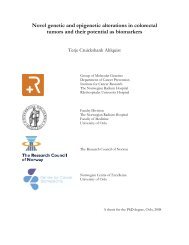Preface - Ous-research.no
Preface - Ous-research.no
Preface - Ous-research.no
Create successful ePaper yourself
Turn your PDF publications into a flip-book with our unique Google optimized e-Paper software.
Vilhelm Magnus Laboratory for Neurosurgical Research<br />
direct comparison of human CB spheres with neurospheres<br />
derived from the human subventricular zone (SVZ). They<br />
found that both CB and SVZ spheres contained a population<br />
of neural progenitors, but that CB spheres, as opposed to<br />
SVZ-spheres, also contained cells with an epithelial phe<strong>no</strong>type,<br />
as judged by morphology, ultrastructural characteristics,<br />
expression of epithelial markers, and downregulation of<br />
neural progenitor markers.<br />
Recently the team has shown that cells from the human iris<br />
pigmented epithelium (IPE) form spheres in culture with<br />
similar properties to those derived from the CB. They have<br />
also shown that such cells can be isolated with a minimal<br />
invasive surgery, the peripheral iridectomy, thus suggesting<br />
the putative scenario of autotransplantation. After induced<br />
differentiation, cells from both CB and IPE spheres acquire<br />
a mature neuronal morphology and strongly express more<br />
mature neuronal markers such as beta-III-tubulin and Map-<br />
2. A subpopulation of the beta-III-tubulin-positive cells also<br />
shows robust expression of rhodopsin, a marker of mature<br />
photoreceptors. Thus, spheres derived from the human CB<br />
and IPE have the ability to differentiate into neuronal-like<br />
cells, including photoreceptors.<br />
Håvard K. Skjellegrind started as a PhD student in 2010. He<br />
is doing live imaging of single cells, aiming to identify the<br />
“true stem cells” in heterogeneous <strong>no</strong>rmal stem cell and<br />
tumour stem cell cultures. To identify expression of specific<br />
genes in live cells, the cells are labelled with genetically driven<br />
reporter constructs. Fluorescent protein coding genes<br />
linked to the promoter sequence for cell type-specific genes<br />
were transferred to the cells using lentiviral vectors. These<br />
vectors were created by Yasu Watanabe whilst working<br />
at the Australian National Adult Stem Cell Centre. By live<br />
fluorescence microscopy, expression of the genes can be<br />
assessed. We expect these experiments will reveal insights<br />
into developmental events in both <strong>no</strong>rmal and tumour<br />
development. Our lab possesses reporters for neural stem<br />
cells, glia, neurons, Schwann cells, and dopaminergic neurons.<br />
Mitochondrial membrane potential is also examined in<br />
single cells as a potential marker for “stemness”.<br />
Towards tissue repair<br />
An avenue where adult human neural stem cells offer<br />
tremendous promise is in the treatment of degenerative<br />
diseases such as Parkinson’s disease. Parkinson’s disease is<br />
characterized by loss of pigmented dopamine-secreting<br />
cells in the substantia nigra. Though transplantation of embryonic<br />
stem cell- or fetal stem cell-derived dopaminergic<br />
cells has shown promising results, the results have <strong>no</strong>t been<br />
consistent. Furthermore, the ethical issues regarding the<br />
use of the aforementioned cell types, limit their clinical use.<br />
Dopaminergic cells derived from adult human brain stem<br />
cells have obvious benefits: firstly, they pose <strong>no</strong> ethical challenges<br />
and secondly, they make autologous transplantation<br />
possible. We are investigating the potential of adult human<br />
brain stem cells to develop into dopaminergic neurons.<br />
PhD graduate Mercy Varghese obtained preliminary results<br />
that in vitro, adult human brain stem cells can develop into<br />
neurons expressing tyrosine hydroxylase, a rate-limiting<br />
enzyme in dopamine synthesis.<br />
Wayne Murrell joined the Vilhelm Magnus lab as Senior<br />
Scientist at the end of 2007. Wayne is from Australia and<br />
for the previous seven years has led laboratory <strong>research</strong> at<br />
Griffith University, Brisbane, on neural stem cells derived<br />
from a region of the peripheral nervous system, the olfactory<br />
mucosa. Wayne is first author of a paper Multipotent<br />
stem cells from adult olfactory mucosa (Murrell et al, Dev<br />
Dyn 2005) which demonstrates the potential to generate<br />
neurospheres, direct their differentiation towards neuronal<br />
and <strong>no</strong>n-neuronal lineages and suggests autologous tissue<br />
repair is a real possibility. This paper was pivotal in gaining<br />
support from the Australian Federal Government for the<br />
establishment of an Australian National Adult Stem Cell<br />
Centre in Brisbane working on human-derived neural stem<br />
cells for potential to treat human disease. Wayne has broad<br />
experience in the fields of molecular, developmental and<br />
cell biology. In recent times he has investigated stem cell<br />
transplant in various animal models of disease including<br />
Parkinson’s, heart attack, disc degeneration and motor neuron<br />
diseases (Murrell et al, Stem Cells 2008, Spine J 2009, Dis<br />
Model Mech 2010, N Engl J Med 2010). Now he helps guide<br />
the efforts of the <strong>research</strong>ers of the Vilhelm Magnus lab. Any<br />
effective tissue replacement therapy will require capability<br />
to produce authentic stem/progenitor cells in bulk quantities<br />
whilst maintaining cell integrity.<br />
We have <strong>no</strong>w developed culture methods for the rapid<br />
isolation, maintenance and proliferation of undifferentiated<br />
adult stem cells. Many suggestions for improvement made<br />
by former Post-Doc John Bianco have been quantitated<br />
systematically by Wayne Murrell and Emily Telmo. Today, a<br />
robust technique for the culture of these cells in billions is<br />
<strong>no</strong>w established. At present, studies are being performed to<br />
assess the fate of these stem cells and their differentiation<br />
potential. Directed differentiation of these cells towards a<br />
specific fate such as down the dopaminergic pathway to<br />
obtain dopaminergic neurons is being examined.<br />
What are the cellular processes of healing What is involved<br />
in tissue repair Surgical ablation of vital brain tissue or<br />
the damage accidents cause to the spine and subsequent<br />
27
















